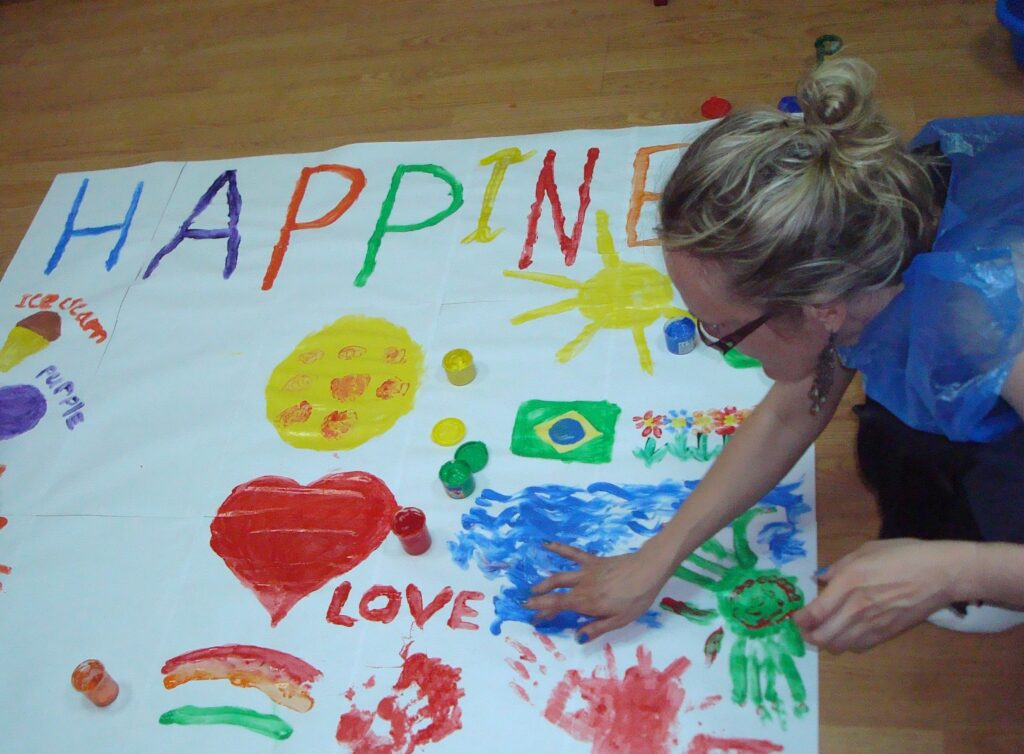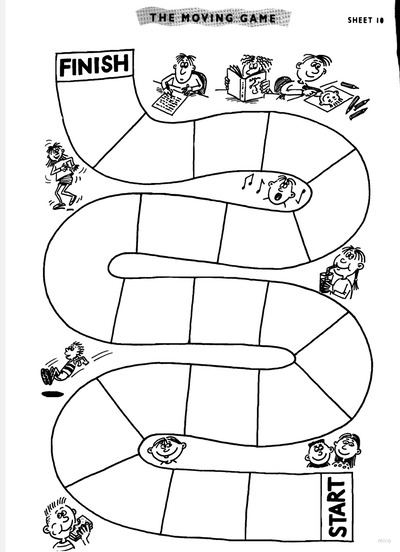
Here is a little post I wrote, about 5 easy to prepare, low-key and YL-friendly and YL teacher-friendly activities that can be prepared with almost no time investment.
One: a boardgame
Boardgames are fun and they are of a great help not only because they provide opportunities to practise vocabulary and structures but also because they help with kids learning to play in pairs or teams, to learn to take turns and to cooperate.
The most basic set includes a printed board, like the one that can be found in Heinemann Children’s Games (published in 1995, omg), featured in the photo below, a dice, a set of checkers. Apart from that, the teacher also needs a set of flashcards or mini-flashcards. The students play the game and every time they land on a box, they pick up a card from the pile and use the word in a relevant sentence (ie they say if they like the food item on the card or they ask their partner a question). Once used, the cards go to the bottom of the pile to be used again. If there are more than one team playing, it is good to use a few sets of cards ie Do you like with animals, food and toys etc. Unless, of course, the teacher has time to photocopy and to cut up the mini-cards.
Here are some useful tricks:
- Instead of letting the kids roll the dice on the table, give each team a plastic cup with the dice inside and show them how they should shake it in order to get a number. This will prevent the dice from rolling off the tables and slowing the game.
- Instead of checkers, you can use a set of small paper toys, colourful paperclips, colourful magnets or even simple colourful pieces of paper on which the kids can write their names. I also like to use stickers (still unpeeled, on small pieces of paper). This way, no matter who actually wins the game, everyone wins and the sticker is their reward.
- Do not worry if you do not have enough time to play the game until the very end, from Start to Finish. This way of playing is only a convention. The game is still fun if the teacher sets the alarm clock for 5 minutes, for example, and then finishes the game, provided that all the players within a team have had the same number of turns. After the game is stopped, the winner is whoever is the closer to FINISH.

Two: I spy with my little eye
The only thing that is needed is a picture, some kind of an illustration, taken either from the website or from the electronic form of the coursebook. I do recommend Starters, Flyers and Movers picture wordlists which can be downloaded for free and which include amazing picture scenes for all the topics relevant to these exams and levels. To be honest with you, it is one of my professional dreams that Cambridge University Press publishes them and makes them available for purchase.
These can be printed or just displayed on the interactive whiteboard or on the computer screen. Kids play in pairs but everyone is using the same picture. The basic version of the game includes the more traditional version of the game (I spy with my little eye something big / small and something green / blue / yellow etc) but it can be transformed into any picture-based riddles or description game or Yes / No game and in that case any vocabulary and structures can be involved.
Here are some useful tricks:
- There are many variations of picture-based activities. You can find lots of ideas in my previous posts from the series All you need is …a picture which you can find here and here
- If you have a dice (or even better – a dice per pair or per team of students), you can also use the same illustrations in a dice description game
- There are plenty of illustrations available. I do recommend Starters, Flyers and Movers picture wordlists which can be downloaded for free and which include amazing picture scenes for all the topics relevant to these exams and levels. To be honest with you, it is one of my professional dreams that Cambridge University Press publishes them and makes them available for purchase. I also like to use any of the Starters, Flyers and Movers materials, the speaking visuals, the reading visuals, listening part 1 visuals. Lots and lots is happening in these pictures and they are appropriate for the younger YL.
- Don’t forget to check out the silly picture scenes used by the speech therapists. They are lovely, colourful and fun and kids really (really) like them. I wrote about them a few years ago and I am still a huge fan.
- As regards the older YL, I still use the activities with different visuals: photographs from the google search engine, the higher levels exams (PET, FCE, CAE and CPE past papers, especially the speaking visuals). I also love using the materpieces of the world’s art but, admittedly, finding these might take a bit longer unless you have your set of go-to paintings.
Three: Tell me about it on Wordwall
This, thanks to all the tools available on wordwall, has become one of my go to games. It is a set of pictures (template: Open the Box), with a number of points in each box. Kids work in pairs, they choose the box and they have to say something about the visual in each box. With the higher levels of primary or the older students, the teacher assigns a number of sentences that they have to produce. With the younger students, the teacher gives clear instructions regarding the language expected. Here is one example for the year 1 kids of the pre-A1 level: toys. During the game the kids could produce the following structures: It is a teddy bear. It is brown. It is old. I don’t like it.
The game is a great one because it works with individual students and groups, big and small. Everyone plays together and everyone produces because even if there is one student responsible for choosing the number of the box, everyone can say something about the picture.
I like to play the game as one of the first competitive games with a group of young learners, only we play it teacher vs all the kids (and I do my best to lose:-)
Here are some tricks
- If you don’t feel like preparing these, go to wordwall, you can find all my games in the community. I made all of them public. You can find them here or you can enter wordwall and look for my profile Azapart.
- The range and the number of structures can be adapted to the age and the level of the kids. I play this game with my preschoolers and my primary students but also with my juniors and teens.
Four: Riddles
Riddles are, by far, one of my favourite games with any age, with the youngest of students and with my teenagers and adults, too. In order to make it work, we only need a set of flashcards or a set of mini-flashcards. I have already written a (great) post about it and you can find it here.
Five: A list of words
I have to admit, I love being a lazy teacher and I always award myself some extra points for all these occassions when I figure out how to be lazy and effective. One of my favourite ready-to-use resources are the word lists from our coursebooks. Sometimes, these can be a set of pictures + words (younger students), sometimes a table with all the key words, for all the older students, juniors and teens. Sometimes, these are the lists that the teacher has to create, especially if we talk about the higher level groups and about working on the vocabulary related to a text (reading or listening). All of the activities below are used to give the students a chance to use the words again and again and again, they are a part of the controlled and freer practice stages of the lesson.
Tricks or some of the ways in which I like to use these lists:
- The list is used as the basis for riddles (see above).
- Questions: students work in pairs, to ask each other questions about the chosen items. Depending on the vocabulary set, these questions can range from very simple (‘Do you like…?’), in a variety of tenses, especially if they are verbs (‘How often do you..?’, ‘Did you…?’, ‘Have you ever…?’, ‘Are you planning to…?’)
- Pairs: students work in pairs and look for ways of pairing up the words and phrases, based on: similar meaning, same first letter, same part of speech, some logical connection, to name a few.
- Ordering: students organise the words according to one or more criteria i.e. the important and the less important words, the easy and the difficult, the familiar and the unfamiliar etc or, simply, organising them in the order of importance or preference to the student and then comparing their new lists with other students and justifying their choices.
- Similar or different: students choose a pair of words or phrases for their partner to decide if these two are similar or different and to explain why. This is, by far, my favourite one, especially for the older and for the higher level students.
Happy teaching!